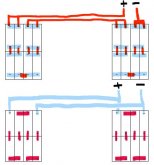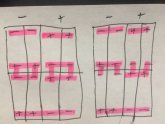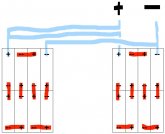Hello -
I'm in the final planning stage of a build out and have a couple of questions. Only way for me to fit the 16 180Ah CALB cells I'm planning for is in two boxes of 8 each on either side of my camper. It's a 24V, 360Ah system, but wondering if I need to be concerned about the side that's nearer to my loads (right side in pics below) taking a bigger hit than the one that's on the opposite side. My original plan was to simply arrange them in the first configuration below (2-12V/360Ah banks connected in series across the aisle), but wondering if connecting 2-24V/180Ah banks in parallel across the aisle might keep the 2 sides more evenly matched, even if that config would be a PITA for a BMS (16 cells to balance vs 8). Blue, below, are the parallel connections and Red are the series.

Biggest load I can expect will be from a 1500W induction cook top (via Victron MultiPlus 24/3000/50) that I expect will draw about15A [Edit: 70A] from my bank but not for long periods. With charging, I suppose they could see 30-40amps going in for extended periods (from 4 24V 300W panels or the MultiPlus). Maybe it's not a big deal as long as I size the wires running between the 2 banks adequately. They'll be about 4 feet long. Will likely run 2 pairs across for the first config so I can go w/ higher gauge (smaller wire) than for the bottom config. Any recommendations/suggestions?
And lastly, anyone have any good recommendations for a (free/online?) software tool to draw schematics? Would like to be able to insert pics of the components I'm using and then diagram the wiring between them. Tried both Word and Visio but both are tedious if you need to move something or rearrange things to make the wiring easier to conceptualize. Guess I'm spoiled after having figured out Google SketchUp for the 3D physical layout of everything. Couldn't imagine having figured all that out without it.
Thanks Folks!
I'm in the final planning stage of a build out and have a couple of questions. Only way for me to fit the 16 180Ah CALB cells I'm planning for is in two boxes of 8 each on either side of my camper. It's a 24V, 360Ah system, but wondering if I need to be concerned about the side that's nearer to my loads (right side in pics below) taking a bigger hit than the one that's on the opposite side. My original plan was to simply arrange them in the first configuration below (2-12V/360Ah banks connected in series across the aisle), but wondering if connecting 2-24V/180Ah banks in parallel across the aisle might keep the 2 sides more evenly matched, even if that config would be a PITA for a BMS (16 cells to balance vs 8). Blue, below, are the parallel connections and Red are the series.

Biggest load I can expect will be from a 1500W induction cook top (via Victron MultiPlus 24/3000/50) that I expect will draw about
And lastly, anyone have any good recommendations for a (free/online?) software tool to draw schematics? Would like to be able to insert pics of the components I'm using and then diagram the wiring between them. Tried both Word and Visio but both are tedious if you need to move something or rearrange things to make the wiring easier to conceptualize. Guess I'm spoiled after having figured out Google SketchUp for the 3D physical layout of everything. Couldn't imagine having figured all that out without it.
Thanks Folks!
Last edited:





